Publications
Check the latest through Google Scholar
2025
-
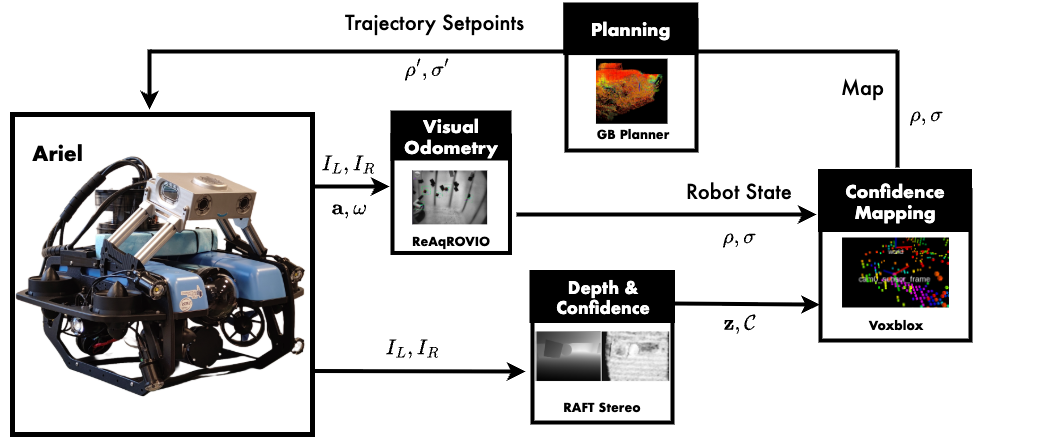 Uncertainty Aware Mapping for Vision-Based Underwater RobotsAbhimanyu Bhowmik, Mohit Singh, Madhushree Sannigrahi, and 2 more authorsPresented at the IEEE ICRA Workshop on Field Robotics, 2025
Uncertainty Aware Mapping for Vision-Based Underwater RobotsAbhimanyu Bhowmik, Mohit Singh, Madhushree Sannigrahi, and 2 more authorsPresented at the IEEE ICRA Workshop on Field Robotics, 2025Vision-based underwater robots can be useful in inspecting and exploring confined spaces where traditional sensors and preplanned paths cannot be followed. Sensor noise and situational change can cause significant uncertainty in environmental representation. Thus, this paper explores how to represent mapping inconsistency in vision-based sensing and incorporate depth estimation confidence into the mapping framework. The scene depth and the confidence are estimated using the RAFT-Stereo model and are integrated into a voxel-based mapping framework, Voxblox. Improvements in the existing Voxblox weight calculation and update mechanism are also proposed. Finally, a qualitative analysis of the proposed method is performed in a confined pool and in a pier in the Trondheim fjord. Experiments using an underwater robot demonstrated the change in uncertainty in the visualization.
@article{bhowmik2025uncertainty, title = {Uncertainty Aware Mapping for Vision-Based Underwater Robots}, author = {Bhowmik, Abhimanyu and Singh, Mohit and Sannigrahi, Madhushree and Ludvigsen, Martin and Alexis, Kostas}, journal = {Presented at the IEEE ICRA Workshop on Field Robotics}, year = {2025}, }
2023
-
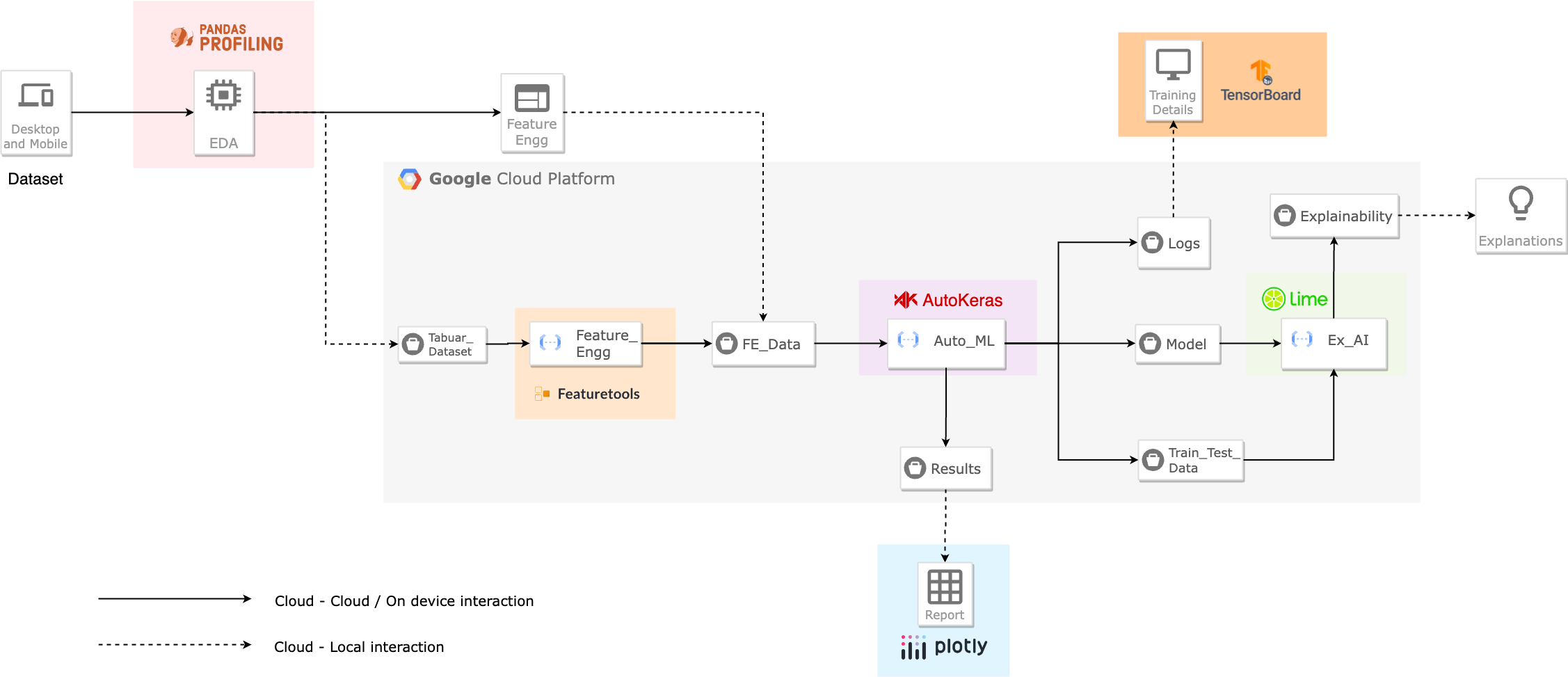 CloudAISim: A toolkit for modelling and simulation of modern applications in AI-driven cloud computing environmentsAbhimanyu Bhowmik, Madhushree Sannigrahi, Deepraj Chowdhury, and 2 more authorsBenchCouncil Transactions on Benchmarks, Standards and Evaluations, 2023
CloudAISim: A toolkit for modelling and simulation of modern applications in AI-driven cloud computing environmentsAbhimanyu Bhowmik, Madhushree Sannigrahi, Deepraj Chowdhury, and 2 more authorsBenchCouncil Transactions on Benchmarks, Standards and Evaluations, 2023There is a very significant knowledge gap between Artificial Intelligence (AI) and a multitude of industries that exist in today’s modern world. This is primarily attributable to the limited availability of resources and technical expertise. However, a major obstacle is that AI needs to be flexible enough to work in many different applications, utilising a wide variety of datasets through cloud computing. As a result, we developed a benchmark toolkit called CloudAISim to make use of the power of AI and cloud computing in order to satisfy the requirements of modern applications. The goal of this study is to come up with a strategy for building a bridge so that AI can be utilised in order to assist those who are not very knowledgeable about technological advancements. In addition, we modelled a healthcare application as a case study in order to verify the scientific reliability of the CloudAISim toolkit and simulated it in a cloud computing environment using Google Cloud Functions to increase its real-time efficiency. A non-expert-friendly interface built with an interactive web app has also been developed. Any user without any technical knowledge can operate the entire model, which has a 98% accuracy rate. The proposed use case is designed to put AI to work in the healthcare industry, but CloudAISim would be useful and adaptable for other applications in the future.
@article{bhowmik2023cloudaisim, title = {CloudAISim: A toolkit for modelling and simulation of modern applications in AI-driven cloud computing environments}, author = {Bhowmik, Abhimanyu and Sannigrahi, Madhushree and Chowdhury, Deepraj and Dey, Ajoy and Gill, Sukhpal Singh}, journal = {BenchCouncil Transactions on Benchmarks, Standards and Evaluations}, volume = {3}, number = {4}, pages = {100150}, year = {2023}, publisher = {Elsevier}, }
2022
-
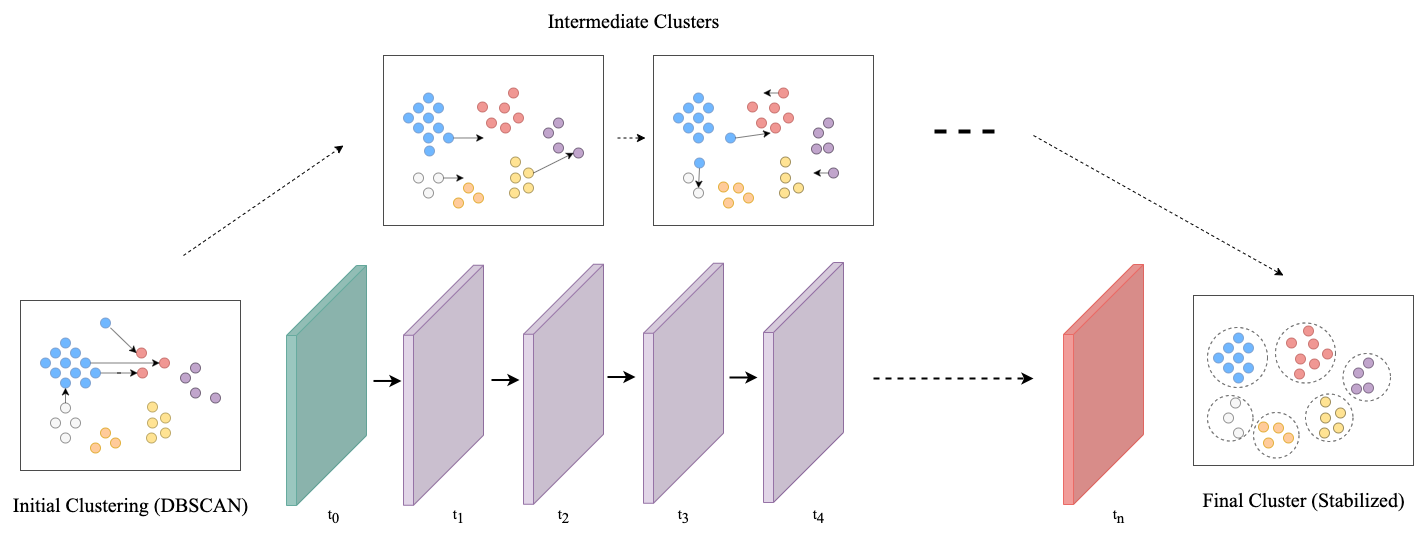 DYNAMITE: Dynamic aggregation of mutually-connected points based clustering algorithm for time series dataAbhimanyu Bhowmik, Madhushree Sannigrahi, Prithwish Guha, and 2 more authorsInternet Technology Letters, 2022
DYNAMITE: Dynamic aggregation of mutually-connected points based clustering algorithm for time series dataAbhimanyu Bhowmik, Madhushree Sannigrahi, Prithwish Guha, and 2 more authorsInternet Technology Letters, 2022Time‐series clustering typically entails clustering similar patterns across various time scales or comparing various point trajectories. However, this study emphasizes to group data points based on their motions and forecast how the clusters will evolve across a number of immediate time frames. To achieve this, we propose a DYNamic Aggregation of Mutually‐connected poInts clusTEring (DYNAMITE) based clustering algorithm for time series. DYNAMITE is based on the interaction between points in a time series and it majorly consists of three components: (1) cluster initialization; (2) calculation of mutually connected points; and (3) cluster updating.
@article{bhowmik2023dynamite, title = {DYNAMITE: Dynamic aggregation of mutually-connected points based clustering algorithm for time series data}, author = {Bhowmik, Abhimanyu and Sannigrahi, Madhushree and Guha, Prithwish and Chowdhury, Deepraj and Gill, Sukhpal Singh}, journal = {Internet Technology Letters}, volume = {6}, number = {6}, pages = {e395}, year = {2022}, publisher = {Wiley Online Library}, } -
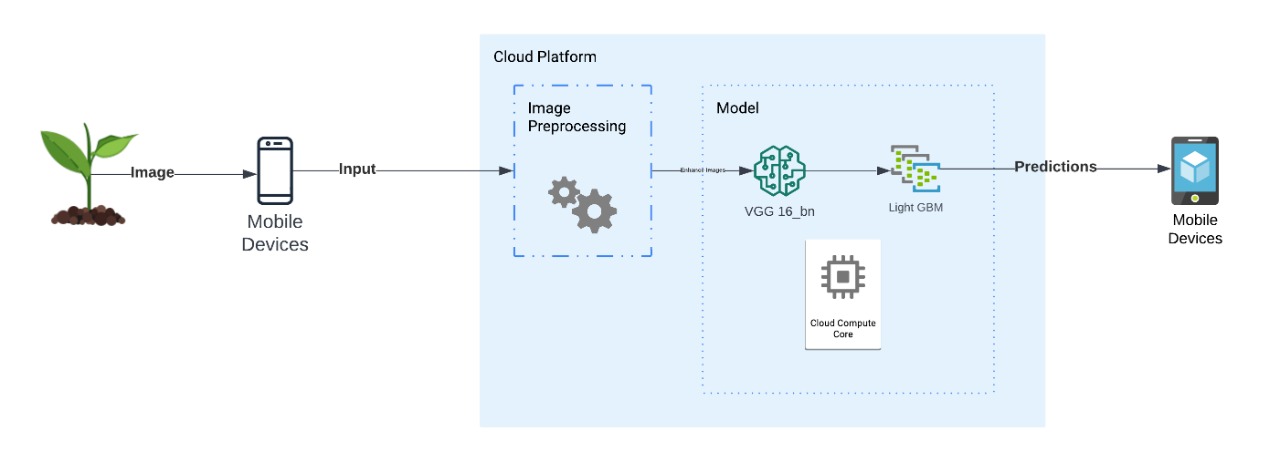 RiceCloud: A Cloud integrated Ensemble learning based Rice leaf Diseases Prediction SystemAbhimanyu Bhowmik, Madhushree Sannigrahi, Deepraj Chowdhury, and 1 more authorIn 2022 IEEE 19th India Council International Conference (INDICON), 2022
RiceCloud: A Cloud integrated Ensemble learning based Rice leaf Diseases Prediction SystemAbhimanyu Bhowmik, Madhushree Sannigrahi, Deepraj Chowdhury, and 1 more authorIn 2022 IEEE 19th India Council International Conference (INDICON), 2022Rice is one of the primary food items consumed by the humans. Farmers in developing countries like India face a lot of problems while cultivating the rice crop. One of such major problem is of rice leaf disease. A plethora of research has been carried out by the data scientist and machine learning expert to detect the disease of the rice leaf from the images. In the research, researchers had mostly used deep learning techniques to detect the rice leaf disease. In this paper, an ensemble learning architecture has been proposed, where the image is given input to a very famous transfer learning neural network, VGG 16 which is pretrained with ImageNet dataset and the features from the penultimate layer is considered as a input to the Light GBM. The Ensemble learning model is deployed on Heroku with a end to end user interface that can be accessed from mobile. The proposed method has given an accuracy of 96.49% , where trained with 80% images of dataset and validated on rest 20% while classifying 4 types of rice leaf disease.
@inproceedings{bhowmik2022ricecloud, title = {RiceCloud: A Cloud integrated Ensemble learning based Rice leaf Diseases Prediction System}, author = {Bhowmik, Abhimanyu and Sannigrahi, Madhushree and Chowdhury, Deepraj and Das, Debanjan}, booktitle = {2022 IEEE 19th India Council International Conference (INDICON)}, pages = {1--6}, year = {2022}, organization = {IEEE} } -
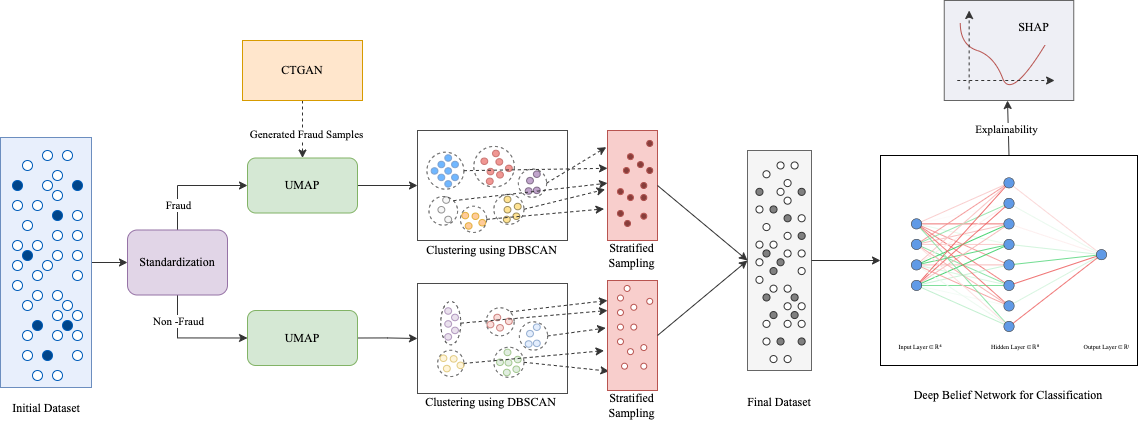 DBNex: Deep Belief Network and Explainable AI based Financial Fraud DetectionAbhimanyu Bhowmik, Madhushree Sannigrahi, Deepraj Chowdhury, and 2 more authorsIn 2022 IEEE International Conference on Big Data (Big Data), 2022
DBNex: Deep Belief Network and Explainable AI based Financial Fraud DetectionAbhimanyu Bhowmik, Madhushree Sannigrahi, Deepraj Chowdhury, and 2 more authorsIn 2022 IEEE International Conference on Big Data (Big Data), 2022The majority of financial transactions are now conducted virtually around the world. The widespread use of credit cards and online transactions encourages fraudulent activity. Thus, one of the most demanding real-world challenges is fraud detection. Unbalanced datasets, in which there are a disproportionately high number of non-fraud samples compared to incidents of fraud, are one of the key obstacles to effective fraud detection. A further factor complicating the learning process for cutting-edge machine learning classifiers is how quickly fraud behaviour changes. Thus, in this study, we suggest an efficient fraud detection methodology. We propose a unique nonlinear embedded clustering to resolve imbalances in the dataset, followed by a Deep Belief Network for detecting fraudulent transactions. The proposed model achieved an accuracy of 94% with a 70:30 ratio of training-validation dataset.
@inproceedings{bhowmik2022dbnex, title = {DBNex: Deep Belief Network and Explainable AI based Financial Fraud Detection}, author = {Bhowmik, Abhimanyu and Sannigrahi, Madhushree and Chowdhury, Deepraj and Dwivedi, Ashutosh Dhar and Mukkamala, Raghava Rao}, booktitle = {2022 IEEE International Conference on Big Data (Big Data)}, pages = {3033--3042}, year = {2022}, organization = {IEEE}, }